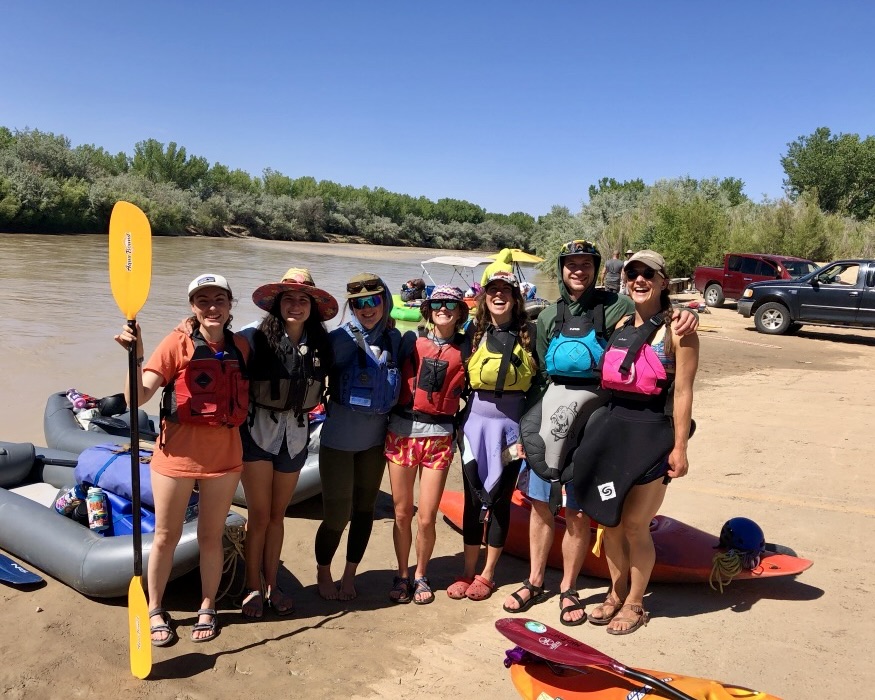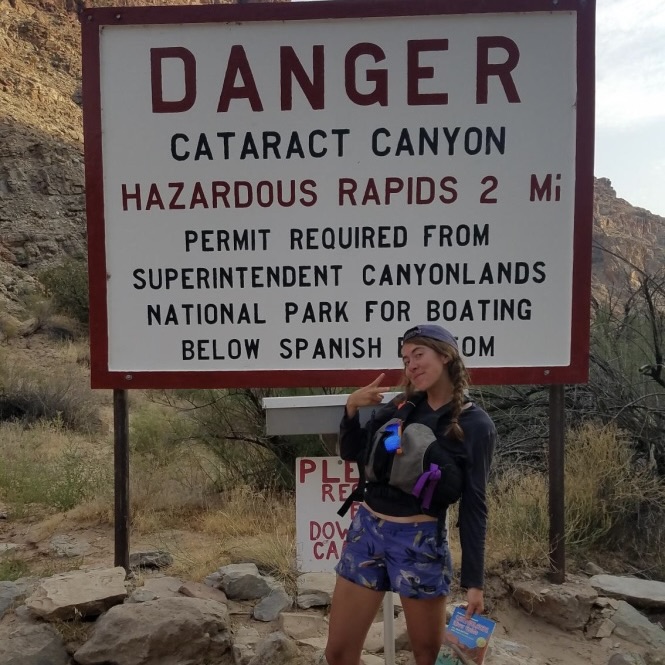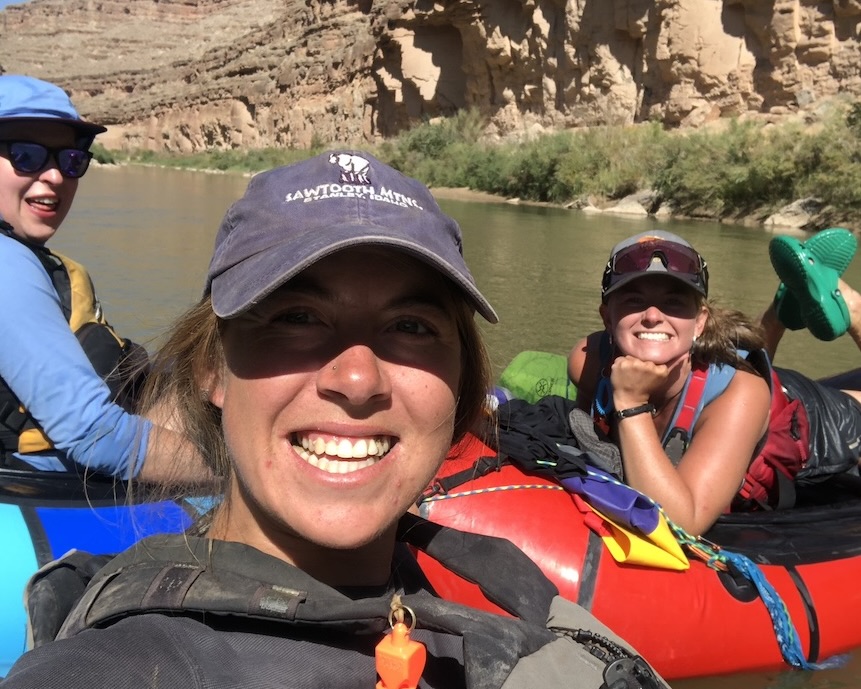Outside (of Gender Norms)
Envisioning and working towards a future when all women and non-binary people can feel the freedom of sunshine on their faces and wind in their hair is a deeply radical endeavor—much more radical than any river I’ve run or line I’ve skied.
On a sunny day in June, the Animas River in downtown Durango, Colorado was running low. The winter’s small snowpack had mostly melted and it had not rained enough to bring the water up. The low river was bad news for everyone and every being—from the farmers who depended on the river for irrigation to the fish and other critters who depended on the water for survival. I was working as a raft guide and the low river certainly made my job tougher.
As I finished pumping air into my boat, I mentally prepared for a technical run navigating my 14 ft raft through a pinball-like course of rocks and the inevitability of getting stuck. In conditions like this, my talent as raft guide could only get me so far. For an enjoyable run, I would also need a little luck.
Luck was in my favor. I only had two customers in my boat that day, a husband and wife, both strong and enthusiastic paddlers. And, with only two passengers, the boat floated lightly over the rocks. The two-hour trip passed by rather quickly. I interpreted the region’s history and geology, explained the challenges of climate change and the regional housing crisis. I shared that I was a student. I navigated technical and rocky rapids with expertise. The customers seemed to be enjoying the experience. As we went around the last bend in the river and I explained that we were ending our trip in the next 5 minutes, the husband interjected.
“You know, when we started this thing and I saw you were going to be our guide, I was kinda…” the husband began, before his wife shushed him and lightly hit him the shoulder. He continued, unperturbed, sharing, “I mean, what I’m trying to say, is you’re pretty good for a girl guide. Like, you’re good at navigating all these rocks.”
Alone in the raft, with just these two people, I was shocked. We had been together in the raft for nearly two hours at this point. I knew about their family, their five kids, his career in engineering. They did not know much about me—they hadn’t really asked—but I had spent the last two hours ensuring their enjoyment, learning, and safety.
Yet, to them, I was still just a girl guide. Thus, my skills must be questioned. Because I was “pretty good for a girl guide” I made sure that the last wave doused the husband with cold water. At the end of the trip, I was left with a sense of frustration that their $20 tip certainly couldn’t override.
This experience was merely a confirmation of what I sometimes suspected of my guests—that they questioned by ability as a guide, due to my gender. I knew that sexism was rampant in the river industry—a serious and often dangerous occupational hazard. I had heard the raft guide jokes that described female raft guides as dirty or promiscuous or incompetent or all three. But the comment still stung. It still stings.
This experience is indicative of the greater social phenomenon of gender exclusion in outdoor recreation. The reality is that the outdoors and, by extension the outdoor industry, still has a serious gender problem. Women and non-binary people consistently face barriers to full participation in outdoor recreation, barriers that range from safety concerns to cultural presumptions. These barriers are exacerbated by intersectional identities including ethnic background, race, sexual orientation, gender expression, ability, weight, socio-economic status, and parenthood.
Who goes outside?
Backcountry Squatters know that the outdoors is not a welcoming place for all people, especially women and non-binary folks. However, others may feel surprised to hear that gender is still a barrier to outdoor recreation participation in 2024. Perhaps it is because surveys estimate that 46%–nearly half—of all outdoor recreation participants are women. Perhaps because there is increasingly representation and celebration of women and nonbinary people in outdoor spaces. However, 46% of participants identifying as female doesn’t tell the entire story of gender inclusivity in the outdoors. If anything, it flattens the cultural reality of the outdoors for many female and nonbinary people.
To begin, not all women and non-binary people have equal access. Race and ethnicity has a significant bearing on access to participation, with people identifying as Black, Indigenous, and People of Color (BIPOC) underrepresented. According to the Outdoor Industry Association, 72% of outdoor recreationalists are white, compared to 59% of all Americans. Researchers from Towson University demonstrate the starkness of this racial divide in the running world; while women presently make up 45% of all marathon runners (compared to just 11% in 1980), only 10% of female runners are African American. In a study of Black women’s experiences with outdoor recreation, “most of the women seemed to have little to no ability to project themselves into the concept of outdoor recreation activities…even though they had tried new activities such as biking, tennis, and swimming.” In fact, the women “did not seem to identify the outdoor activities in which they engaged (e.g., walking, short-distance biking, or tennis) as true outdoor recreation activities.” There are a variety of theories that attempt to explain this phenomenon, however there is a well-established and long-standing cultural dominance of wealthy, white men in outdoor recreation. This cultural exclusion is exacerbated by physical exclusion; from the genocide and displacement of Native Americans in the creation of National Parks to race-based segregation and exclusion from parks, the recent history of exclusion in outdoor spaces reverberates to this day. For example, while 23% of white Americans live in “nature deprived areas,” 74% of nonwhite Americans live in nature deprived areas.
Additionally, the 46% of participants doesn’t account for the type or level of activity. A 2015 study published in the Journal of Leisure Research found that compared to the early 1990s, many of the constraints to female participation in running have diminished, to the point of near gender parity in the sport. However, gender equity only goes so far—literally; longer distance running races have fewer female participants. This phenomenon exists outside of running, too. In the mountains, while 38% of all skiers identify as female, the number drops to 25% for backcountry skiers, a pursuit requiring advanced ski techniques and technical training. Even more starkly, women make up less than 2% of all mountain guides certified by the International Federation of Mountain Guides Association (IFMGA) and only 20% of American Institute for Avalanche Research and Education instructors.
Quality of participation is also lost when solely assessing participation rates. In a survey by climbing community and events organizer, Flash Foxy, women participating in rock climbing reported unwanted staring at twice the rate and microaggressions at nearly three times the rate of men. As my experience raft guiding underlines, the harassment does not end in the leisure realm, but also extends to the industrial dimensions of outdoor recreation, as well; female park rangers have documented experiences of sexual assault and harassment.
Finally—and critically—we currently lack robust data on non-binary and transgender participation in outdoor recreation. However, gender diverse outdoors people consistently share their view that the outdoors is not an inclusive community. While there have been serious successes in inclusivity–pro surfing competitions now allow transgender athletes and the winner of HBO’s climbing competition, “The Climb,” Cat Runner, is transgender— outdoor experiences have not been historically welcoming to nonbinary and LGBTQ+ people. Case studies—such as the one published in the UC Berkeley Parks Stewardship Forum—suggest the many barriers to full participation in outdoor recreation.
Ultimately, these examples demonstrate the long-lasting implications of outdoor recreation’s origins in wealth and patriarchal white supremacy. Outdoor recreation was built to exclude; from the genocide and land dispossession of Native American in the creation of National Parks to the erasure, misrepresentation, and exclusion of BIPOC in historic and present outdoor recreation participation, outdoor recreation in the United States has consistently been a domain for the most privileged. While individual experiences may vary, to this day, there is overwhelming evidence that women and non-binary people—and particularly BIPOC women, LGBTQ+, disabled, and/or low-income–continue to be excluded from full participation in the outdoors.
Pathways forward
Some days, I want to simply go outside and feel the freedom of sunshine on my face, the wind in my hair. I want to solely focus on the joy I feel when I wear cheetah print leggings and glitter and purple lipstick as I boogie down a river; the power I feel when I ski down a technical line. Discussing the continued exclusion of women and non-binary people from the outdoors can feel frustrating, overwhelming, and somedays impossible, as tied up as it is with other forms of social and environmental justice. But envisioning and working towards a future when all women and non-binary people can feel the freedom of sunshine on their faces and wind in their hair is a deeply radical endeavor—much more radical than any river I’ve run or line I’ve skied.
Accomplishing this radical endeavor isn’t easy. It requires sharing vulnerable stories, questioning norms, recognizing your own privilege, and reimagining what the outdoors could look like in the future, just as much as it requires getting outside and laughing until your stomach hurts, pushing yourself further than you ever thought you could, watching the best sunset ever, and helping others get outside, too.
On another a sunny day in June, with the Animas River running low, I finished pumping air into my boat and I mentally prepared for another technical run of the river. I got lucky again this time with a light boat assigned to my boat, a family of three. After the family got in and we launched, the mom turned to me. Shielding her eyes from the sun, she grinned.
“You know, we were so excited when we saw you were going to be our raft guide,” she explained. “When we were waiting, we saw it was all guys expect for you and my daughter was like, ‘I hope we get the girl guide!’ And what do you know? We did.” The young girl, sitting at the front of raft gripped her paddle, and smiled and nodded shyly.
Written by Mara MacDonell- Backcountry Squatters Nonprofit Board Treasurer
keep reading



